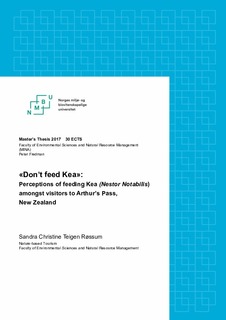| dc.contributor.advisor | Fredman, Peter | |
| dc.contributor.advisor | Espiner, Stephen | |
| dc.contributor.author | Røssum, Sandra Christine Teigen | |
| dc.coverage.spatial | New Zealand | nb_NO |
| dc.date.accessioned | 2018-10-01T10:58:01Z | |
| dc.date.available | 2018-10-01T10:58:01Z | |
| dc.date.issued | 2017 | |
| dc.identifier.uri | http://hdl.handle.net/11250/2565455 | |
| dc.description.abstract | The population status of Kea (Nestor Notabilis) was in 2017 changed from Vulnerable to Endangered on the IUCN Red List of Endangered Species after a rapid decline of 50-80% in the last three generations. Feeding of Kea is by research and experts referred to as an ongoing issue threatening the species. The study aimed to examine the perceptions of feeding Kea amongst visitors in Arthur’s Pass.
The study applied the belief elicitation method from the Theory of Planned Behaviour (TPB) to examine the interactions, attitude and beliefs that visitors to Arthur’s Pass have towards feeding of Kea. Analysing their interactions with Kea suggested that most visitors only watch or photograph the bird, while very few have closer encounters, like feeding or playing with it. Of the 306 visitors who participated in a self-reported questionnaire on-site, only 18 stated having fed Kea. Signs and more knowledge were by the visitors considered important in stopping feeding of Kea. «Don’t feed Kea» was the most remembered message from the signs in Arthur’s Pass, suggesting that this management measure has been effective in targeting the behaviour. The feeders were predominantly domestic visitors with a lot of nature experience, who state to have a lot of knowledge of Kea. There are indications that they might have an attitude of «knowing better» than the park managers, and it might be necessary to find a different approach to stop them from feeding. It is proposed that the interpretation should focus on educating the large group of visitors who might feed if given the opportunity. | nb_NO |
| dc.description.abstract | Kea (Nestor Notabilis) ble i 2017 opplistet fra sårbar til truet på IUCNs rødliste over truede arter etter en rask nedgang på 50-80% i løpet av de siste tre generasjonene. Mating av Kea er i følge forskning og eksperter referert til som et pågående problem som truer arten.
Denne studien anvender «Belief Elicitation» fra Theory of Planned Behaviour (TPB) for å undersøke hva slags kunnskap, holdninger og oppfatninger de besøkende til Arthur's Pass har om mating av Kea. Resultatene viste at de fleste besøkende kun ser på eller fotograferer Kea, mens svært få har hatt nære møter, som å mate eller leker med den. Av de 306 besøkende som deltok i et selvrapportert spørreskjema på stedet hadde bare 18 matet Kea. Skilt og mer kunnskap ble vurdert som viktig i å stoppe mating av Kea. «Ikke mat Kea» var budskapet flest husket fra skiltene i Arthur's Pass, noe som tyder på at dette tiltaket har vært effektivt i å forhindre denne adferden. De som har matet Kea var hovedsakelig besøkende fra New Zealand med mye erfaring med natur, som sier at de har mye kunnskap om Kea. Det er indikasjoner på at de har en holdning om at de «vet bedre» enn forvalterne, som kanskje gjør det nødvendig å finne en annen tilnærming for å hindre at de mater Kea. Det foreslås at naturveiledningen fokuserer på å øke kunnskapen til den nokså store gruppen besøkende som er trolige til å mate Kea dersom de får muligheten. | nb_NO |
| dc.language.iso | eng | nb_NO |
| dc.publisher | Norwegian University of Life Sciences, Ås | nb_NO |
| dc.rights | Attribution-NonCommercial-NoDerivatives 4.0 Internasjonal | * |
| dc.rights.uri | http://creativecommons.org/licenses/by-nc-nd/4.0/deed.no | * |
| dc.subject | Human-wildlife interactions | nb_NO |
| dc.subject | Nestor Notabilis | nb_NO |
| dc.subject | Endangered bird species | nb_NO |
| dc.subject | Wildlife tourism | nb_NO |
| dc.subject | Truede fuglearter | nb_NO |
| dc.subject | Naturveiledning | nb_NO |
| dc.title | «Don't feed Kea» : perceptions of feeding Kea (Nestor Notabilis) amongst visitors to Arthur's Pass, New Zealand | nb_NO |
| dc.type | Master thesis | nb_NO |
| dc.source.pagenumber | 93 | nb_NO |
| dc.description.localcode | M-REIS | nb_NO |

